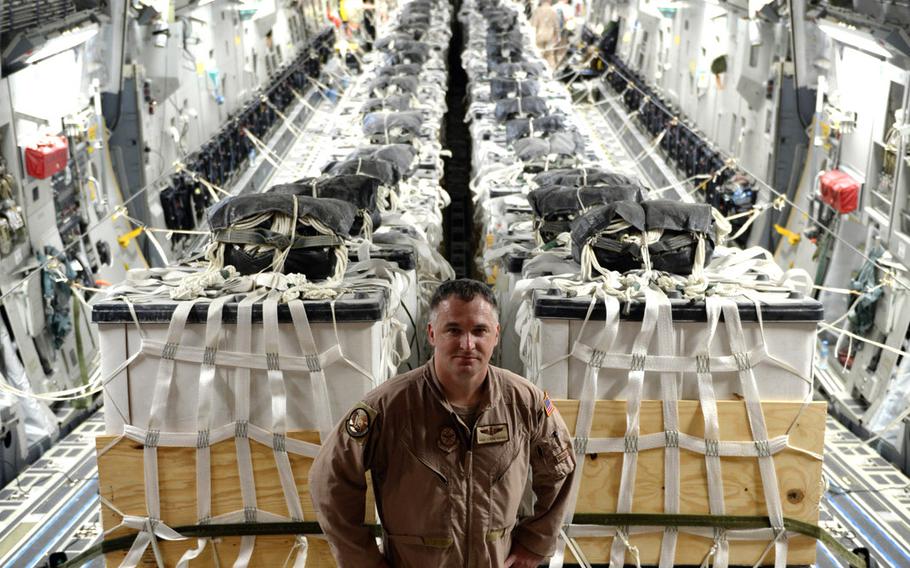
Air Force Master Sgt. Stephen Brown poses in front of 40 container delivery system bundles filled with fresh drinking water on a C-17 Globemaster III in preparation for a humanitarian airdrop over the area of Amerli, Iraq, Aug. 30, 2014. Brown taped candy to most of the bundles in hopes of bringing cheer to displaced Iraqi children. (Shawn Nickel/U.S. Air Force)
A number of U.S. aircrews flying humanitarian assistance missions over the northern Iraqi city of Amerli made a sweet contribution to the relief packages dropped into the besieged town — candy.
Aircrews with the 816th and 746th Expeditionary Airlift Squadrons, based out of Air Forces Central Command, added their own personal care packages to the over 100 humanitarian assistance drops into Amerli as part of the U.S.-led relief efforts.
Tucked into the massive pallets of water and meals ready-to-eat were garbage bags full of Skittles, Starbursts and other assorted candies and sweets.
Only those two squadrons, among the various Air Force units participating in relief operations in Amerli, took on the practice of loading and delivering the candy drops, Air Forces Central Command spokeswoman Capt. Malinda Singleton said.
The decision was a squadron-level one, said Singleton, who noted that the aircrews may include in future airdrops other additions besides sweets.
“Who knows what they may choose to (drop) next time,” she said.
The airdrops were part of a two-pronged U.S. air campaign to back Iraqi security forces fighting to push militants from the Islamic State out of Amerli. American warplanes launched repeated airstrikes against IS positions in and around the area, enabling Iraqi government forces and Kurdish troops to break the siege. The militants had threatened to slaughter 15,000 ethnic Turkmen residents, whom they regard as infidels because they are Shiite Muslims.
For his part, Air Force Master Sgt. Stephen Brown, with the 816th EAS, said the candy drops were just a small thing his aircrew could do to make a devastating situation somewhat better.
“I can just imagine being in the shoes of these parents down there. Not being able to provide much during a time of war would be heartbreaking,” he told an Air Force reporter earlier this week.
“This could be something that will make a dire situation a little brighter, even if it’s just for a few moments,” he added.
While it remains unclear how long the U.S. air mission in northern Iraq will last, Air Force officials expect the units to continue the practice up until the end of their deployment.
Singleton declined to say how long both Air Force units would be in northern Iraq as part of the ongoing humanitarian assistance mission there. She said that expeditionary airlift squadrons usually conduct two- to four-month rotations.